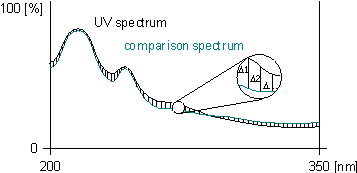Location:
Peak Table and Spectra Library Screening tab pages/ Report Variable (Peak Table)
Type:
Selection
Dimension:
No unit
Value Range:
Least Square, Weighted Least Square, or Correlation
Default:
Least Square
Related Parameters:
Additional parameters for comparing spectra:
Description:
The match criterion defines the mathematical method with which two standardized spectra are compared with each other.
Function:
The signal deviation, that is, the difference between the UV spectrum and a reference spectrum at defined wavelength, is checked (l1, l2, ...). Since the square of the deviations is calculated as well, the direction of the subtraction does not matter.

The method provides a value of similarity (match) between completely different (= 0) and identical (= 1000).
The following mathematical methods are available in Chromeleon:
Least Square:
Forms the sum of the squared signal deviations at each wavelength and determines the average square deviation between two spectra (standard method)
Weighted Least
Square:
Analogue to Least Square; the squared deviations are weighted by the signal height (for spectra extracted close to the detection limit).
Correlation:
Usual match criterion in statistics if a linear correlation between two curves is presumed (similar to Least Square; usually provides the same result).